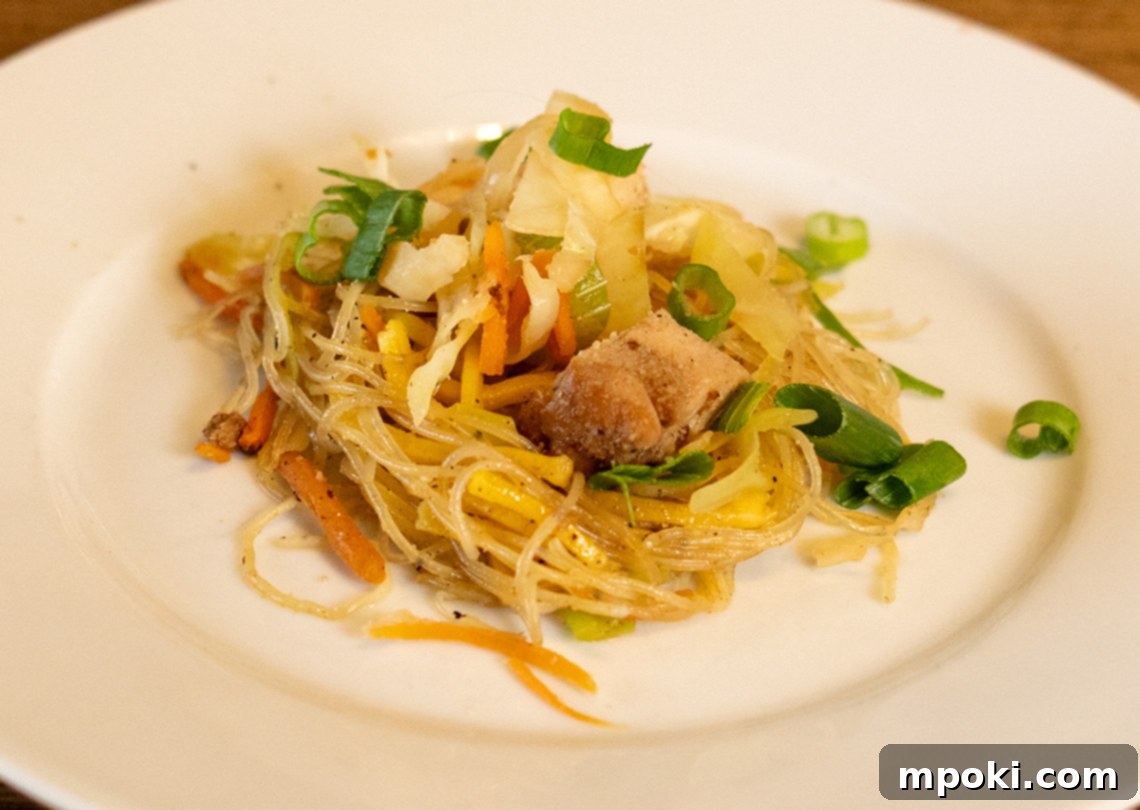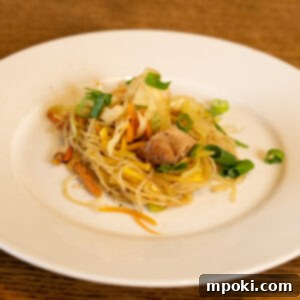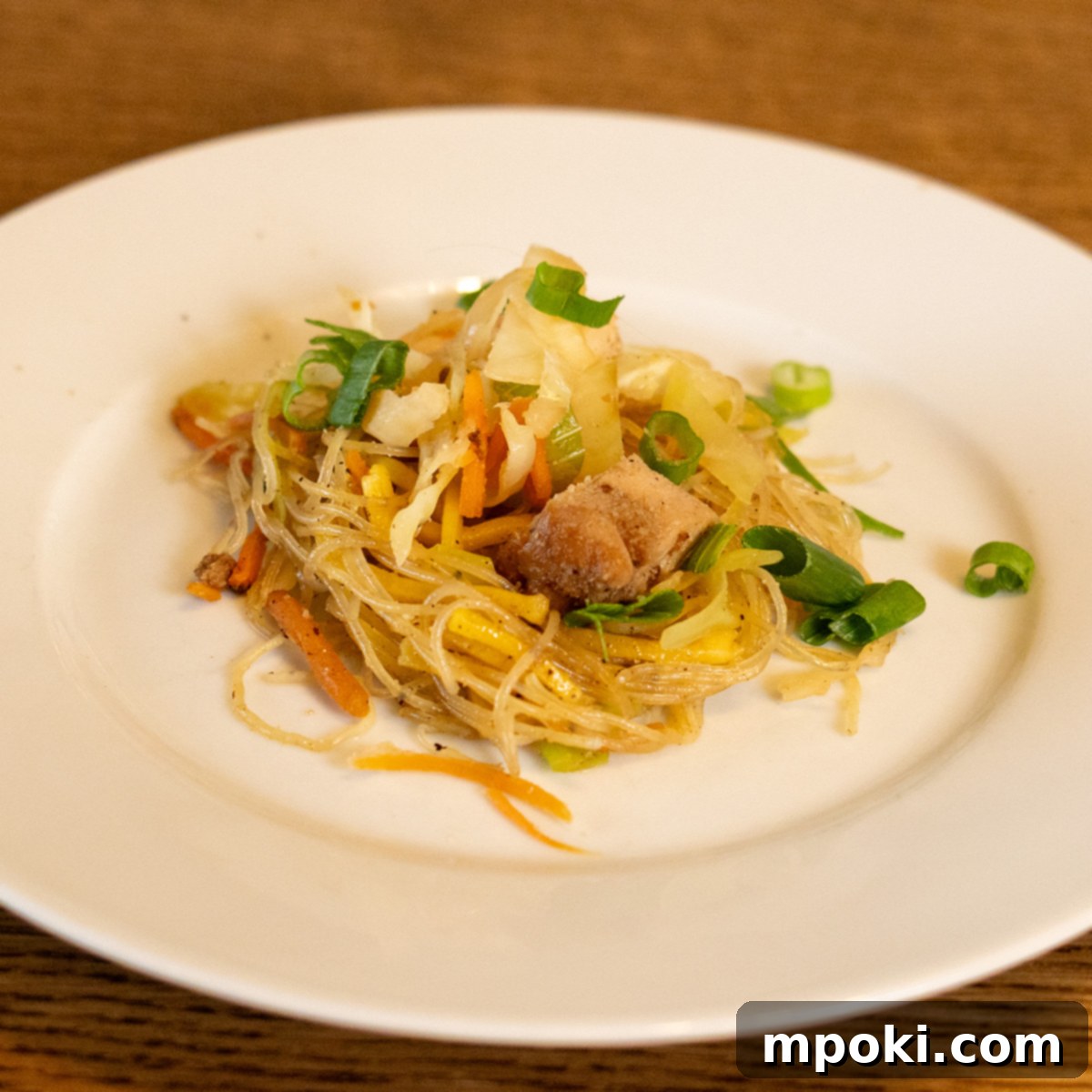Welcome back to Dad Got This, your go-to source for delicious culinary adventures, straightforward recipes, and a healthy dose of dad-grade humor. Today, we’re embarking on a vibrant journey to the Philippines, right from our own kitchens, to create a dish that’s bursting with flavor and tradition: Filipino Pancit.

My latest culinary mission, preparing an authentic Filipino Pancit, came directly from my wife. Seriously, it was a literal request. A work potluck was approaching, and the stakes were high. Failure, as any seasoned dad chef knows, was simply not an option (unless I was prepared for an extended stay on the couch, which, let’s be honest, isn’t ideal for my back).
This Page Contains Affiliate Links. For more Info See My Disclosures here.
Jump to Recipe
Pancit, a true gem of Filipino cuisine, is more than just a noodle dish; it’s a celebration of textures and tastes. It perfectly blends savory meats, crisp-tender vegetables, and slippery noodles, creating a symphony for your taste buds. This particular recipe tackles a classic combination: marinated chicken, a medley of fresh veggies, and a dynamic duo of Canton and Bihon noodles. And of course, no Dad Got This recipe is complete without my secret weapon, Dad Dust—a simple yet powerful seasoning blend designed to elevate every bite. Let’s get cooking!
Filipino Pancit Recipe

Filipino Pancit
A flavorful Filipino Pancit recipe featuring marinated chicken, sautéed vegetables, and both Canton and Bihon noodles. Perfect for potlucks and picky eaters alike, delivering an authentic taste of the Philippines.
Pin Recipe
Main Course
Filipino
authentic, Filipino Pancit, noodle dish
1 day 15 minutes
35 minutes
2347 kcal
Dad Got This
Ingredients
Marinade:
- ½ cup Soy Sauce
- ¼ cup Avocado Oil
- 1 tablespoon Fish Sauce
- 1 tablespoon Sesame Oil
- 2½ lbs Boneless Skinless Chicken Thighs
- Dad Dust (See Note Below for Recipe)
Vegetables:
- 1 Bag Matchstick Carrots (10oz)
- 1 Celery Stalk (Cut on a diagonal)
- 1 Head Cabbage (Shredded)
- 1 Pack Green onions (Diced)
- 1 Onion (Sliced and Chopped)
- Dad Dust (See Note for Recipe)
- Black Pepper (to taste)
- Fish Sauce (to taste)
- Soy Sauce (to taste)
- 1 (32oz) Chicken Stock (as needed)
Noodles:
- 1 (16oz) Canton Noodles
- 1 (16oz) Bihon Noodles
- 1 Box Chicken Stock (32 oz, for noodles)
- 8 Cloves Garlic (Minced)
Optional Addition:
- 1 lb Shrimp (peeled and deveined)
Instructions
Marinate the Chicken:
- Mix all marinade ingredients (soy sauce, avocado oil, fish sauce, sesame oil) in a bowl. Slice the boneless, skinless chicken thighs into bite-sized pieces and season liberally with Dad Dust. Add the chicken and marinade to a gallon-sized freezer bag. Ensure the chicken is thoroughly coated, then refrigerate overnight (or at least 4 hours) to allow the flavors to deeply penetrate the meat.
Cook the Chicken & Veggies:
- Place a large wok or a wide, deep skillet over medium-high heat and add a splash of high-temp oil. Cook the marinated chicken in batches until fully cooked and lightly browned. Avoid overcrowding the pan to ensure proper searing. Between batches, deglaze the wok with a small amount of chicken stock to capture any flavorful browned bits. Transfer cooked chicken to a clean container and set aside.
- Add a bit more oil to the wok if needed. Sauté the diagonally cut celery and matchstick carrots for 2 minutes. Season them with a sprinkle of Dad Dust, a splash of fish sauce, and a splash of soy sauce.
- Add the shredded cabbage along with approximately 1 cup of chicken stock to the wok. Cover and cook for 2 minutes to steam the cabbage. Uncover, stir well, and continue to cook for an additional 3 minutes, or until the cabbage is tender-crisp. Transfer these cooked vegetables to a separate container.
- In the same wok, add a little more oil and sauté the sliced/chopped onions, diced green onions, and minced garlic until fragrant, about 2-3 minutes. Once aromatic, add these to your vegetable container.
Prepare the Noodles:
- While the chicken and vegetables are cooking, begin soaking the Bihon noodles in a bowl of room temperature tap water for exactly 5.5 minutes. Do not oversoak, as they will cook further in the wok.
- Add the Canton noodles directly to the wok with 1-3 cups of chicken stock (start with 1 cup and add more as needed). Stir occasionally, allowing the noodles to absorb the liquid until they are cooked but still have a slight bite (al dente) – this typically takes 3-4 minutes. Strain the noodles, reserving any remaining broth. Set the cooked Canton noodles aside.
- Drain the soaked Bihon noodles thoroughly. Add them to the wok along with the reserved broth from the Canton noodles and a little extra chicken stock if needed. Season with Dad Dust, fish sauce, and soy sauce. Cook uncovered for about 3 minutes, stirring gently, until the Bihon noodles are tender but not mushy.
Cook the Shrimp (Optional):
- If adding shrimp, add a small amount of oil to the wok. Add the peeled and deveined shrimp, seasoning lightly with Dad Dust, sesame oil, fish sauce, and soy sauce. Cook for about 4 minutes, or until the shrimp turn pink and opaque. Taste and adjust seasoning as needed.
Combine & Serve:
- Return all the cooked chicken, vegetables, and (optional) shrimp to the wok with both types of noodles. Gently toss everything together, ensuring all ingredients are well combined and coated in the flavorful sauce. You may also keep proteins separate if serving picky eaters.
- Garnish your freshly made Pancit with fresh sliced lemons and serve immediately with lemon wedges on the side for an extra burst of brightness.
Video Tutorial
Notes from Dad
Dad Dust Recipe: This is my go-to seasoning blend. Add to a shaker bottle, mix well, and use on EVERYTHING!
- 120G Granulated Garlic
- 120G Granulated Onion
- 1 tablespoon MSG (Optional, but highly recommended for umami!)
SEASON AS YOU GO: This is a crucial tip for truly flavorful Pancit. Every time you introduce a new item into the wok – be it chicken, vegetables, or noodles – give it a little seasoning with Dad Dust, fish sauce, and soy sauce. I suggest a “splash,” which is roughly equivalent to a tablespoon. Layering the seasoning like this ensures that every component of your dish is perfectly flavored, leading to a much more cohesive and delicious final product.
Wok Size Matters: For a recipe of this size, especially if you’re cooking for a crowd or a potluck, a large wok is highly recommended. It allows for proper stir-frying and prevents overcrowding, which can lead to steamed rather than seared ingredients.
Noodle Texture: The key to great Pancit is perfectly cooked noodles – tender but with a satisfying chew, never mushy. Keep a close eye on them during cooking, as timing can vary slightly based on noodle brand and thickness.
Nutrition Information
Carbohydrates: 80g |
Protein: 246g |
Fat: 116g |
Saturated Fat: 20g |
Polyunsaturated Fat: 24g |
Monounsaturated Fat: 60g |
Trans Fat: 0.2g |
Cholesterol: 1077mg |
Sodium: 9084mg |
Potassium: 4896mg |
Fiber: 26g |
Sugar: 37g |
Vitamin A: 1364IU |
Vitamin C: 348mg |
Calcium: 568mg |
Iron: 17mg

Tried this recipe?
Mention @DadGotThis or tag #DadGotThis on Instagram!
The Journey to Pancit Perfection
My exploration into Filipino Pancit started, as most great culinary tales do, with a clear directive from the boss (my wife, in case you were wondering). She needed a showstopper for a work potluck, and Pancit was the chosen champion. This wasn’t just about cooking; it was about honoring a rich culinary heritage and, more practically, avoiding the doghouse. With my apron on and my trusty wok at the ready, I embarked on crafting this beloved noodle dish.
Marinating the Chicken: A Flavor Foundation
The journey to an unforgettable Pancit begins with the chicken. I opted for boneless, skinless chicken thighs, cut into manageable, bite-sized strips. Thighs are superior for stir-fries as they remain tender and juicy even under high heat, unlike leaner breasts which can dry out. The marinade is where the magic truly begins: a robust blend of soy sauce for umami and saltiness, avocado oil for a smooth base and high smoke point, savory fish sauce for that unmistakable Southeast Asian depth, and a touch of fragrant sesame oil.
All these ingredients came together in a gallon-sized freezer bag, where the chicken was then introduced and generously coated. The final flourish? A liberal sprinkling of my signature Dad Dust – a powerful mixture of granulated garlic, granulated onion, and a hint of MSG. This overnight spa treatment in the fridge isn’t just about convenience; it allows the flavors to deeply infuse the chicken, ensuring every morsel is packed with taste. This long marination is a fundamental step in building layers of flavor that will shine through in the final dish, setting it apart from a hastily prepared meal.
Cooking the Components: Separate for Success
One of the key lessons in crafting a complex dish like Pancit, especially for a potluck with diverse palates, is the art of cooking components separately. While it might seem counterintuitive for a stir-fry, this method ensures each ingredient is cooked to its optimal texture and allows for customization. Not everyone is on the shrimp bandwagon, and some prefer their protein unmixed until serving. I fired up my wok to a medium-high heat, adding a good high-temp oil like avocado oil. Cooking the chicken in batches was crucial; overcrowding the wok lowers the temperature, leading to steaming rather than a desirable sear. A beautifully browned chicken piece holds more flavor.
A quick pro-tip I picked up: after each batch of chicken, a little deglazing with chicken stock does wonders. It not only captures all those delicious browned bits, adding another layer of flavor back into the dish, but it also makes cleanup significantly easier. This flavorful liquid is gold and will contribute to the richness of the entire Pancit. Once cooked, the chicken was safely tucked away in a container, awaiting its grand reunion with the other elements.
The Vibrant Vegetable Ensemble
Next up were the vegetables, bringing color, crunch, and essential nutrients to the Pancit. I started with the harder vegetables – matchstick carrots and celery cut on a diagonal – tossing them into the hot wok. Seasoning these early with more Dad Dust, a dash of black pepper, a splash of fish sauce, and a hint of soy sauce ensures they absorb flavor from the get-go. After a quick sauté to get them tender-crisp, the shredded cabbage joined the party. A cup of chicken stock was added, and the wok was covered, allowing the cabbage to steam briefly. The goal here is tender-crisp, not soggy. Nobody wants a limp carrot or an overcooked cabbage in their Pancit!
Once the cabbage reached that sweet spot, it was removed and joined the chicken. Finally, the aromatic base: onions, green onions, and minced garlic. Sautéed quickly until fragrant, these foundational flavors are vital for the overall depth of the dish. This systematic approach allows each vegetable to retain its individual character while contributing to the collective harmony of the Pancit.
The Noodle Narrative: Canton vs. Bihon
The star of any Pancit is, undoubtedly, the noodles. For this recipe, we employ two distinct types: Canton and Bihon, each bringing its unique texture and absorption qualities. This duality is what gives Pancit its characteristic satisfying mouthfeel. I began by soaking the delicate Bihon noodles in room temperature water. This gentle pre-softening is key; they’re thin and can easily become mushy if cooked improperly. A precise 5.5 minutes of soaking is usually all they need.
Meanwhile, the heartier Canton noodles went straight into the wok with a generous pour of chicken stock. These thicker noodles are designed to absorb liquid and flavor directly, creating a rich, savory coating. I stirred them occasionally, allowing them to soak up all that liquid gold until they were cooked but still delightfully chewy. The beauty of this step is that the noodles become sponges for the broth’s essence. Once perfectly al dente, I carefully strained them, reserving the flavorful broth – a critical ingredient for the Bihon noodles.
Then came the Bihon noodles’ turn. Drained and ready, they absorbed their own bath of the reserved, seasoned broth, along with a little extra chicken stock. A quick pan-fry with some more Dad Dust, fish sauce, and soy sauce ensured they were perfectly seasoned and cooked, yet still retaining that pleasant chew. And yes, a quick confession: I forgot the minced garlic earlier, so I fried some up on the fly and mixed it in. Hey, improvisation is part of the dad-chef charm!
Optional Shrimp and the Grand Assembly
For those who love a little extra something, shrimp makes an excellent addition to Pancit. Quickly stir-fried in the wok with a touch more seasoning, they add a sweet, briny counterpoint to the chicken and vegetables. Seasoning them lightly with Dad Dust, sesame oil, fish sauce, and soy sauce enhances their natural flavor without overpowering. They cook quickly, typically just 4 minutes, until they turn pink and opaque.
Finally, the moment of truth: combining all the elements. The cooked chicken, the vibrant vegetables, the optional shrimp, and both types of perfectly seasoned noodles were returned to the wok. A gentle toss brought everything together, allowing the flavors to meld and intertwine. This creates a cohesive dish where every forkful offers a medley of textures and tastes. For families with picky eaters (and let’s be honest, whose isn’t?), keeping the proteins separate until serving is a smart move, ensuring everyone enjoys their plate. A garnish of fresh lemon slices and a few lemon wedges served on the side add a bright, acidic finish that cuts through the richness and truly elevates the dish.
Why This Pancit is a Winner
This isn’t just any Pancit; it’s a testament to thoughtful cooking, flavor layering, and adapting traditional techniques for the home kitchen. Was this an authentic Pancit passed down through generations in a Filipino family? Perhaps not in the strictest sense of familial tradition, but it was made with genuine love, decent technique honed from countless kitchen experiments, and a deep respect for the vibrant flavors of Filipino cuisine. And, most importantly, it passed the ultimate test: the wife test. She loved it, which means it’s a verified success in the Dad Got This kitchen!
So, if a white guy with a penchant for dad jokes and an adventurous spirit can whip up a passable (and more than passable, dare I say, delicious!) Pancit, then you absolutely can too. This recipe proves that you don’t need decades of experience to create something truly special and satisfying. It’s about being bold in your culinary experiments and trusting the process.
Because at the end of the day, when it comes to delicious, crowd-pleasing meals, Dad Got This.
Ingredient and Equipment Links:
Fish Sauce: https://amzn.to/4iVq76C
Did you know Dad is on YouTube?
Go check out Dad’s YouTube channel for all kinds of great cooking videos and food-related content. You’ll find more easy-to-follow recipes, kitchen tips, and, of course, plenty of dad humor!
